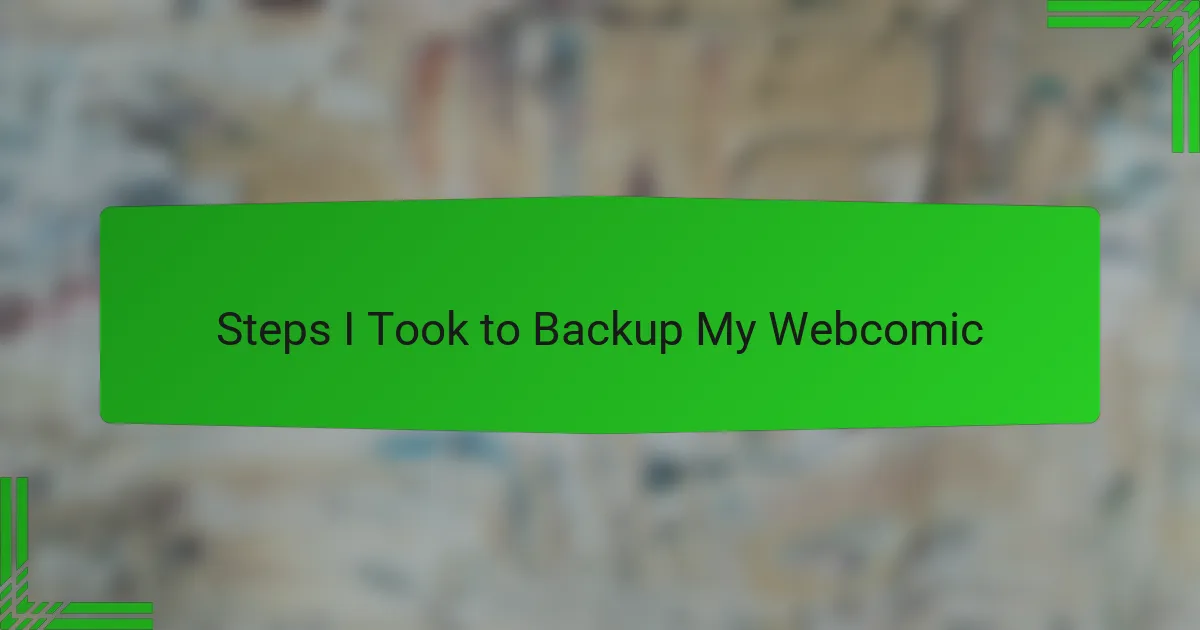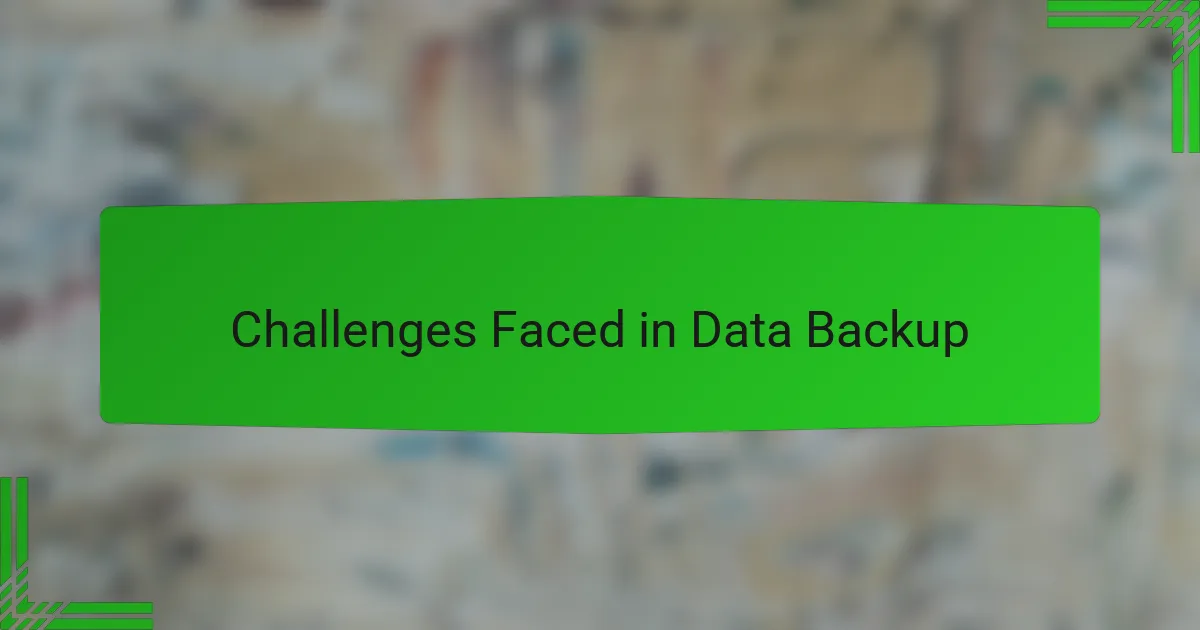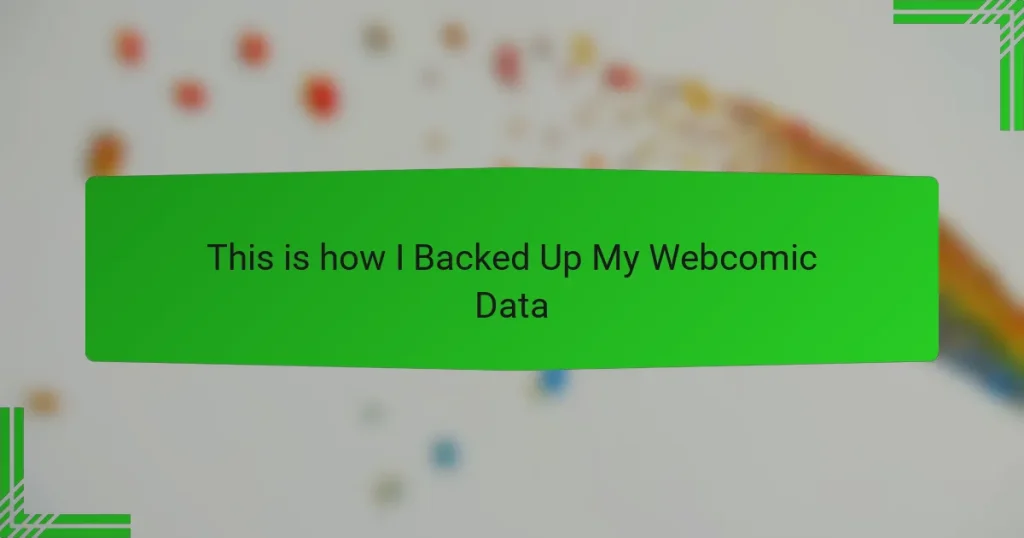Key takeaways
- Webcomic archives are essential for preserving artists’ work and allowing fans to explore an artist’s creative journey.
- A combination of cloud storage and physical backups is recommended to safeguard webcomic data effectively.
- Organizational tools like cloud storage, consistent file naming, and project management software can streamline workflows and enhance creativity.
- Regularly checking backups and using version control can significantly reduce the risk of data loss and improve peace of mind while creating.

Understanding Webcomic Archives
When it comes to webcomic archives, understanding their significance cannot be overstated. These archives serve as digital time capsules, preserving the creativity and hard work of artists like me. I remember the early days of my webcomic; the thought of losing all that effort was terrifying. Having reliable backups helps me sleep better at night, knowing that my stories are safe.
Additionally, webcomic archives are invaluable for fans. They allow readers to immerse themselves in the history of an artist’s work. I often revisit my older comics to see how my style has evolved, and seeing them safely stored away gives me a sense of pride. The emotional connection to my creations amplifies the importance of having a well-maintained archive.
Here’s how various types of online storage can be compared regarding webcomic archival:
| Storage Type | Pros |
|---|---|
| Cloud Storage | Accessible from anywhere, automatic syncing |
| External Hard Drive | Large capacity, one-time purchase |
| Self-Hosted Website | Full control, can customize backup methods |

Importance of Data Backup
The importance of data backup cannot be overstated, especially when it comes to creative projects like webcomics. I vividly remember a time when I lost an entire chapter due to a sudden computer crash. The feeling of despair was overwhelming; it made me realize how vulnerable my artistic work was without a solid backup plan in place. Since then, I prioritize safeguarding my data to avoid that gut-wrenching experience again.
In my experience, a small amount of regular effort in backing up data can save you from significant heartbreak down the line. Whether it’s an accidental deletion or a technical failure, knowing that you have a backup brings peace of mind and allows you to focus on creating, rather than worrying about losing your hard work.
- Protects against data loss from hardware failures.
- Mitigates the risk of losing work due to human error.
- Provides a safety net against cyber threats such as malware.
- Allows you to retain previous versions of your work for reference or reuse.
- Ensures you can share and collaborate without the fear of data loss.

Best Backup Methods for Webcomics
When it comes to backing up webcomic data, I’ve found that a combination of cloud storage and physical backups works best. Cloud services like Google Drive provide ease of access and automatic syncing, which means I can retrieve my work from anywhere. However, relying solely on the cloud can feel a bit risky, so I also keep an external hard drive with copies of my files. This dual approach gives me peace of mind, knowing my artwork is safe.
I remember when I had a scare with my old laptop crashing and almost losing years of work. That experience made me extremely proactive about backups. It taught me how important it is to have multiple backup methods in place. Trust me, you don’t want to be in a position where your creativity gets sidelined because of a technical failure.
| Backup Method | Pros |
|---|---|
| Cloud Storage | Accessible anywhere, automatic backups |
| External Hard Drive | Physical control, no internet needed |
| USB Flash Drive | Portable, easy to use |
| Local Server | Great for privacy, customizable |

Tools for Organizing Webcomic Files
When I first started organizing my webcomic files, I quickly realized the importance of having the right tools at my disposal. It was a chaotic scramble to manage everything, and I found myself stressed over lost scenes or misplaced drafts. Discovering organizational software made a world of difference; it not only helped me sort my files but also freed up mental space for creativity.
I remember one late-night panic when I couldn’t find a character design I had spent hours creating. It was then I turned to cloud storage and project management tools, which allowed me to keep everything in one easily accessible location. With these tools, my workflow became more streamlined, and I finally felt in control.
Here are some essential tools that can help organize your webcomic files effectively:
– Cloud Storage (e.g., Google Drive, Dropbox): Keeps your files safe and accessible from anywhere.
– File Naming Conventions: Create a consistent system for naming files to easily identify content.
– Project Management Software (e.g., Trello, Notion): Helps track progress and manage deadlines.
– Graphic Design Software: Use tools like Adobe Photoshop or Clip Studio Paint for character designs and layouts, organizing them in dedicated folders.
– Backup Solutions (e.g., external hard drives): Always have a reliable backup to prevent any data loss.
These tools not only help keep my files in order but also give me peace of mind as I focus on what I love – creating my webcomic.

Steps I Took to Backup My Webcomic
Backing up my webcomic data was crucial, especially after putting my heart and soul into every panel. I still remember the sinking feeling when I realized I hadn’t saved my files for a few days. It motivated me to come up with a solid backup plan that I could rely on.
Here are the steps I took to ensure my webcomic was safe:
-
Cloud Storage: I opted for a reliable cloud storage service. Not only does it provide access from anywhere, but it also gives me peace of mind knowing my data isn’t confined to my physical device.
-
External Hard Drive: I invested in an external hard drive specifically for my webcomic files. I copy everything to it weekly, creating a physical backup just in case the unexpected happens.
-
Version Control: Using a version control system made a significant difference. It allows me to track changes and revert to earlier versions, which has saved me from a few minor “oops” moments!
-
Regular Check-Ins: Every month, I set aside time to check my backups to ensure everything is working correctly. This routine helps me stay aware and feel more in control of my work’s safety.
Ultimately, taking these steps filled me with confidence. I could focus more on creating rather than worrying about potentially losing everything.

Challenges Faced in Data Backup
Backing up my webcomic data presented a few challenges that I hadn’t anticipated. For instance, I once lost a week’s worth of artwork due to a faulty external hard drive. It was a frustrating experience that taught me the importance of redundancy; relying on just one backup option is risky.
I also found that navigating different file formats and software compatibility posed some hurdles. Choosing the right tools can be overwhelming, and I often second-guessed my choices. To help others avoid these pitfalls, here are a few key challenges I encountered:
- Hardware Failures: External drives can fail without warning.
- Software Compatibility: Not all backup solutions play nicely with every file format.
- Accidental Deletion: It’s easy to mistakenly delete files when managing backups.
- Time Constraints: Backup processes can be time-consuming, and it’s easy to put them off.
- Overlapping Versions: Managing multiple backup versions can lead to confusion about which one is the most up-to-date.




